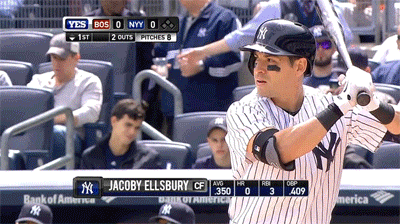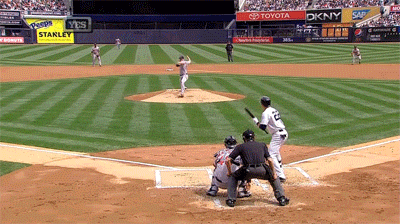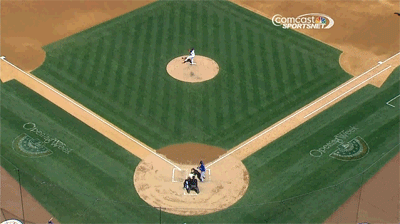Last week I started a season-long series devoted to tracking bunts for base hits with the infield shift in effect; this is the second installment. To bring you up to speed on the series’ premise and methodology will take but two brief excerpts. Excerpt one:
Teams are shifting more often; they're shifting not only at higher rates against the usual slow-footed, southpaw sluggers who are classic shift candidates, but also against more marginal hitters whom they wouldn't have bothered to defend before, down to and including Ryan Flaherty; the math suggests that it makes sense for an average hitter to attempt a bunt with third base open as long as he has a >=40 percent chance to get it down; and the more common the shift is, the more worthwhile it becomes for a hitter who hasn't had to do it before to invest the time necessary to become a competent bunter (as extreme pull hitter Brandon Moss did this spring).
More and more teams are getting on the defensive positioning bandwagon. At some point, the batters will strike back, using one of the only anti-shift tactics available.
And excerpt two:
Inside Edge tracks defensive shifts and bunts with the shift in effect, so they’ll be supplying the data for this series. According to IE, there were 40 bunts against the shift in 2012, and 50 in 2013. Of those 90 bunts, 56 led to hits, so you can see why the bunt is so smart: At that success rate, it makes sense for any hitter who can get a bunt down to do so with the bases empty, and the worse the hitter and the emptier the left side of the infield, the better a play it becomes.
And now you’re caught up. Today, we’ll cover the games of April 10-16, with the list of bunts against the shift again supplied by Inside Edge. We have two new bunts to talk about, both by hitters who didn’t try this tactic from 2012–13.
Date: 4/12
Batter: Jacoby Ellsbury, Yankees
Bunts against the shift by this batter from 2012–2013: 0
Pitcher: John Lackey
Inning: 1
Outs: 2
Count: 2-1
Runners: 0
Outcome: Single
“The shift” makes defensive positioning sound like a binary decision between a standard alignment and a single, non-standard one. Of course, it’s more nuanced than that; fielders can be placed not only at the extremes of the standard–non-standard positioning spectrum, but at every point in between. This is what the alignment against Ellsbury looked like:
The second baseman (not pictured) is in his appointed place, and the shortstop is pinched only slightly toward the middle. But third baseman Jonathan Herrera is playing about halfway between the second- and third-base bags. Is that a shift? For our purposes, I think so, since Ellsbury probably wouldn’t have done what he did had Herrera not been there.
On the first pitch of the plate appearance, Ellsbury squared to bunt but pulled back, causing Herrera to start in before looping back to the same spot.

On 2-1, Ellsbury squared again, but this time he went through with it.
Because he had to circle around the ball to get a good angle rather than coming in on it directly, Herrera’s throw went wide and pulled Mike Napoli off the base. Had the throw been on line, Ellsbury might have beaten it out anyway.

So let that be a lesson to us (and to teams): Bunting to beat the shift doesn’t require the full-on “Ted Williams” overshift, the one with an infielder stationed in shallow right. A speedy runner like Ellsbury can take advantage of even a slight change in positioning.
Date: 4/16/2014
Batter: Anthony Rizzo, Cubs
Bunts against the shift by this batter from 2012–2013: 0
Pitcher: Masahiro Tanaka
Inning: 7
Outs: 0
Count: 0-0
Runners: 0
Outcome: Single
…And, right after explaining why not every bunt to beat the shift has to be against a team that left the whole left side of the infield open, we get one that was. On Wednesday, Anthony Rizzo caught the Yankees shifting, ending a streak of 14 consecutive batters retired by Masahiro Tanaka. He's not exactly a natural, but he did get it down, and in the right direction.

This week’s close encounters
On Sunday, Danny Espinosa bunted down six runs and with a runner on second, chipping the ball over Aaron Harang’s head:

Inside Edge classified that a bunt against the shift, which seems strange if you look at the infield alignment immediately after the bunt:
Check right before the bunt, though, and you can see what they were thinking:

This is a borderline case, especially since it’s not clear that Espinosa intended to bunt the ball to the left side. I’m going to exclude this one from the stats. We do have to draw the line somewhere.
Twitter Tips
@ben_lindbergh For your beating-the-shift logbook: Brandon Moss just attempted a bunt on the 1st pitch in the 9th but fouled it off.
— Nathan Aderhold (@AdrastusPerkins) April 17, 2014
Mitch Moreland, facing the shift, squared to bunt. Must have been reading @ben_lindbergh today.
— Joe Hamrahi (@JHamrahi) April 12, 2014
Related links: Mike Petriello on Matt Adams’ Adam Dunn-like embrace of the opposite field.
Season Totals
Bunts against the shift in 2014: 5, 4 successful
Bunts against the shift through this date in 2013: 3
Bunts against the shift through this date in 2012: 0
Thank you for reading
This is a free article. If you enjoyed it, consider subscribing to Baseball Prospectus. Subscriptions support ongoing public baseball research and analysis in an increasingly proprietary environment.
Subscribe now


